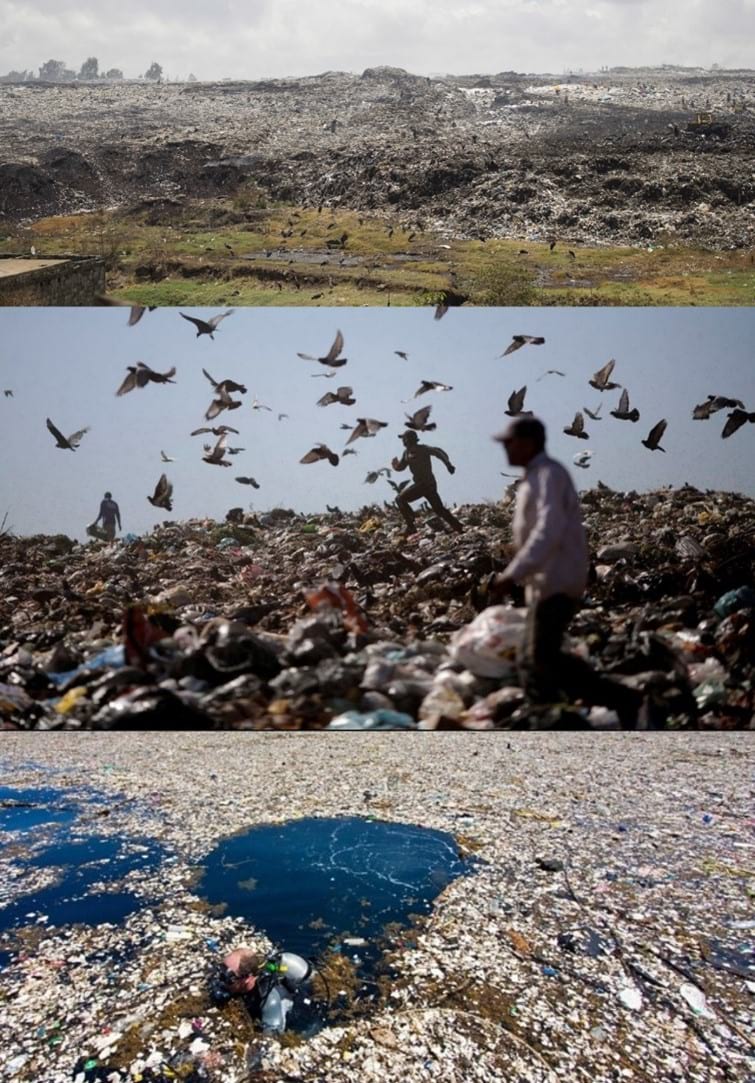
Image: 21st centuary ecological disasters. Top: Dandora dumpsite, East-Africa’s largest landfill, Kenya. Image by Katharina Elleke. Middle: Brasilia’s estrutural landfill, image from BBC news. Bottom: Plastic accumulation in the sea, image from Egypt independent.
I- State of the art¶
Since the 19th century and the industrial revolution, consumption habits changed: previously characterized by the consumption of reusable, long lasting objects made from natural resources (wood, metals, glass), they are now centered around overconsumption of disposable single use goods made out of non-renewable and highly modified materials like plastics.
A- Data on the fast fashion impact on the environment¶
Producing around 10% of the global carbon emissions, fashion industry is one of the most polluting industries in the world, and is yet still expanding (clothing production has doubled between 2000 and 2014). It is worth more than 2.5 trillion $USD and employing over 75 million people worldwide, with strong lobbies to back up any attempt to reduce it. It produces over 100 billion garments a year, out of which 85% go to the dump before the end of that period (UNECE, 2018).
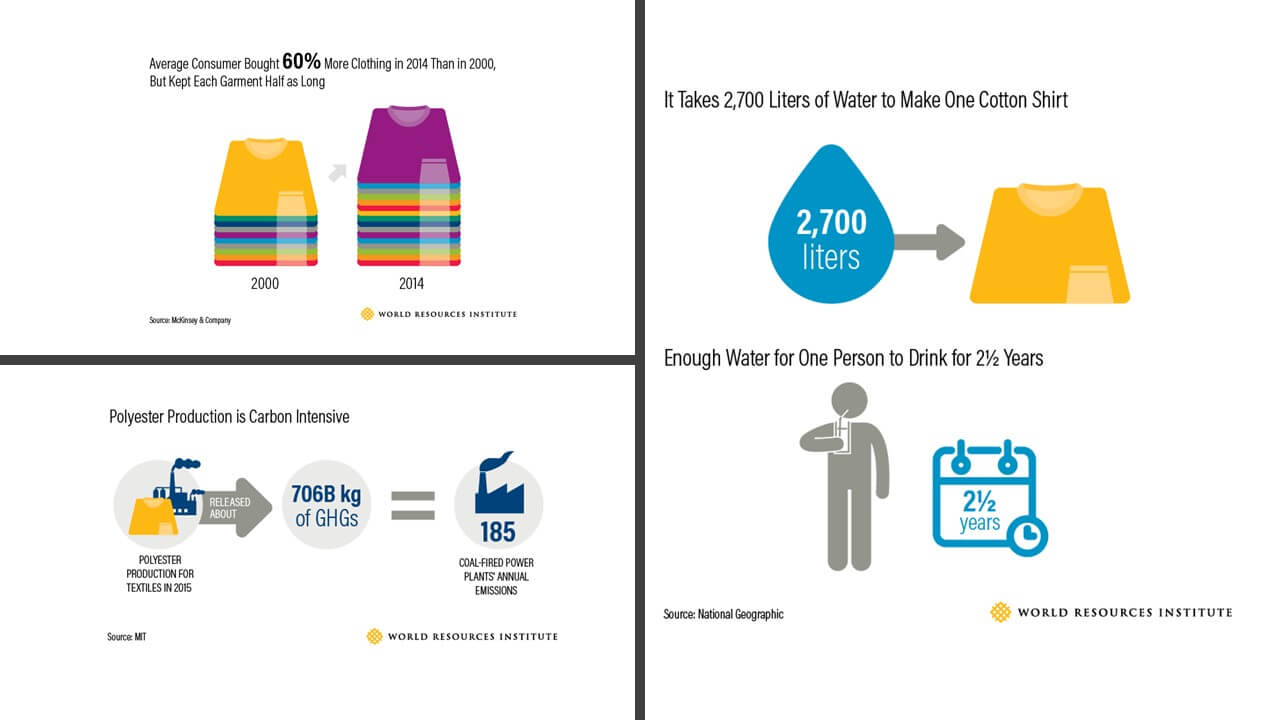
Image made from inforgraphy found on the World Ressource Institute.
The Geneva environment network offers a very nice documentation with reliable sources. The following paragraph is an extract of their website.
"The Environmental Footprint of Fast Fashion:
- The equivalent of one garbage truck full of clothes is burned or dumped in a landfill every second (UNEP, 2018)
- Approximately 60% of all materials used by the fashion industry are made from plastic (UNEP, 2019)
- 500,000 tons of microfibers are released into the ocean each year from washing clothes — the equivalent of 50 billion plastic bottles (Ellen MacArthur Foundation, 2017)
- The fashion industry is responsible for 8-10% of humanity’s carbon emissions – more than all international flights and maritime shipping combined (UNEP, 2018). If the fashion sector continues on its current trajectory, that share of the carbon budget could jump to 26% by 2050 (Ellen MacArthur Foundation, 2017)
- Some 93 billion cubic metres of water – enough to meet the needs of five million people – is used by the fashion industry annually, contributing significantly to water scarcity in some regions (UNCTAD, 2020)
- Around 20% of industrial wastewater pollution worldwide originates from the fashion industry (WRI, 2017)."
Considering the depletion of the petroleum resources and the ecologic disaster caused by the accumulation of plastic wastes in landfills and oceans, nowadays’ challenges are to discover new materials to replace the ones currently used, fashion industry included. These materials need to be more ecofriendly during the production process, biodegradable, renewable and cheap in raw materials to compete with the existing ones on the market.
Because of these characteristics, new materials inspired by techniques and materials widely used before industrialization (low techs) have seen their number rise. Examples of these materials would be alginate paper, cardboard, bamboo, or glass. On the other hand, some materials are also being developed such as poly-hydroxy alcanoate (PHA) plastics, alginate bioplastics or mycelium materials, which are the focus of this tab.

Image: bioplastics of agar, alginate and gelatine made by Lucrecia Strano, Fabricademy 2019.
B- Mycelium and fungal life cycle¶
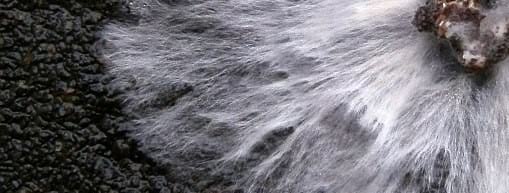
Fungi are eukaryotic organisms of the reign of the opisthokonts. They are different from plants in the way that they are not able to produce their own organic matter through photosynthesis but feed by breaking down the organic matter they find in their environment. They feed by extracellular digestion (absorption or exodigestion) mediating the secretion of enzymes in their medium to hydrolyze molecules (The kingdom fungi, Steven L. Stephenson, chapter 1).
The life cycle of fungi can be divided into 3 different stages: spores, mycelium and fruiting body. When put in favorable heat, moisture and food conditions, spores germinate and start forming an hyphae or mycelium, commonly considered as the “root of the fungus”. The hypae grows and feeds on soil until accumulating enough nutrients and can form a fruit body when the temperature gets lower and the oxygen level gets higher (overall conditions generated when the mycelium reaches the surface).
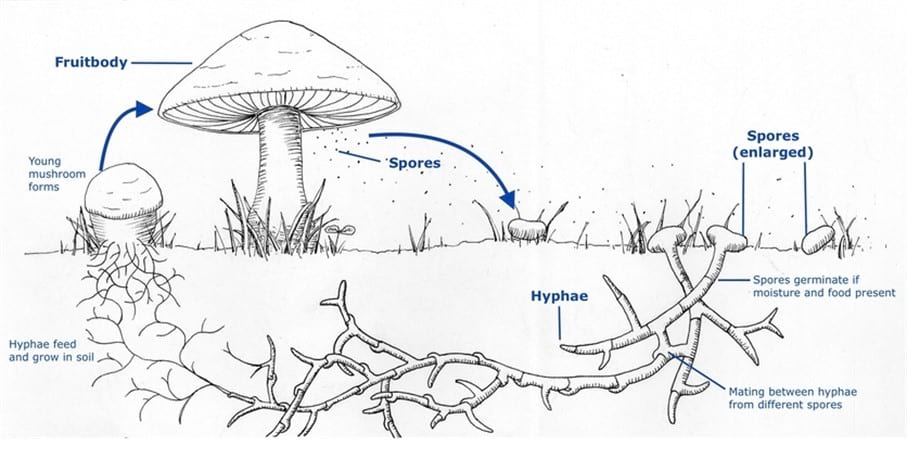
Image: filamentous fungi life cycle. Source : science learn.
The hyphae can grow with sexual or asexual reproduction. Sexual reproduction occurs when two hyphae from different spore mate and generate an offspring with a different genetic backup, allowing the species to evolve and to adapt to new environmental conditions. However, the hyphae can still grow in an haploid state without mating and nevertheless generate a fruit body.
C- Mycelium materials¶
The mycelium of filamentous fungi is a network of tubular cells. They can be grown in an anthropogenic context and used in production processes to form composite mycelium materials (CMM) or pure mycelium materials (PMM). CMM materials consist in a substrate that can be digested by the mycelium, shaped in a mold, and inoculated by the fungal strain of choice. The mycelium colonizes the feedstock, binds the substrate particles together and fills void spaces, acting as a biological glue. When dehydrated, an object in the shape of the mold is generated. The CMM are light, have foam-like materials characteristics, antibacterial proprieties, are water-resistant and fireproof. On the other hand, PMM consist in only mycelium unattached from their substrate (Vandelook 2021).
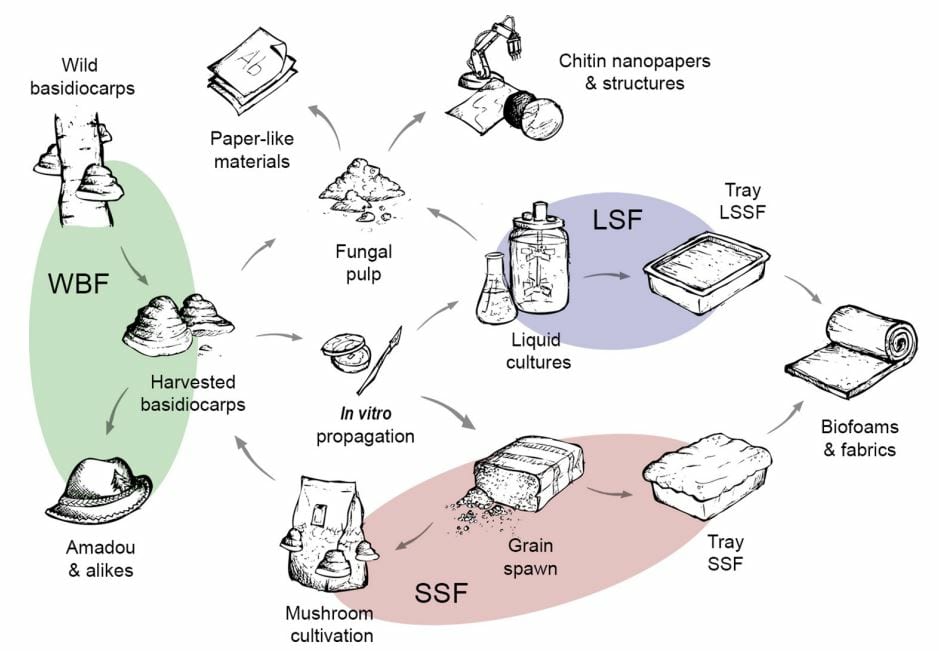
Image: Overview of the different flexible fungal materials (FFM) existing and their production method. WBF: Wild Basidiocarp Foraging, LSF: Liquid-State Fermentation, LSSF: Liquid-State Surface Fermentation, SSF: Solid-State Fermentation. Source: Gandia 2021.
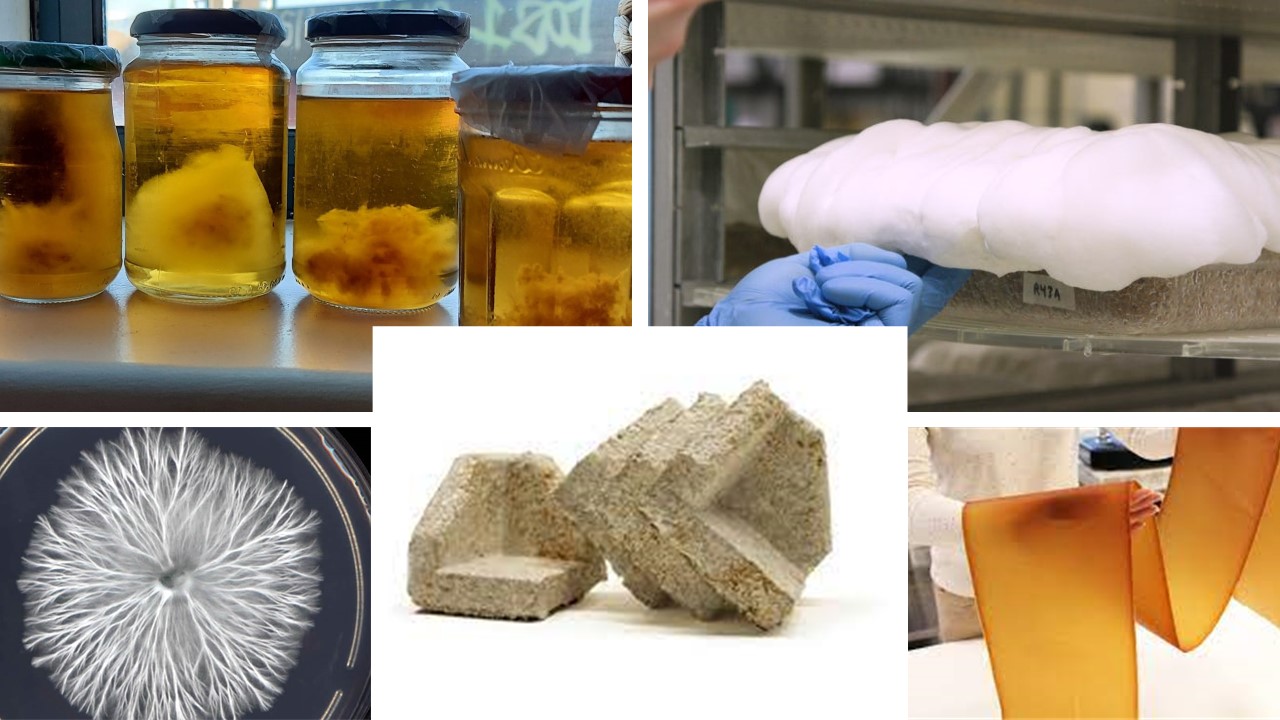
Image: examples of CMMs and PMMs. a: Woodchips and Mycelium composite used for packaging, by Ecovative. B. Mycelium liquid culture. c: mycelium grown on agar plates. D: mycelium foam, AirMycelium by Ecovative. E: VTT’s continuous mycelium leather.
D- Pure Mycelium Materials (PMM)¶
PMMs are being produced and sold in the form of skincare products, leather fabrics, foams or even meat alternatives. Some of the main companies working on these products are VTT Technical Research Centre of Finland, MycoWORKS, Mycotech Lab, Bolt Threads and Ecovative. Currently, the PMMs that can be used for the textile industry are mainly PMM foams and PMM sheets (Mylo™, Reishi™, Mylea™, Forager™). These materials are very competitive with the other alternatives of the market, such as bovine or synthetic leather, as they display similar physical proprieties, require few raw materials and only take 5 to 14 days to grow when using the adequate fermentation setup.
| Leather-like material | Source | Tensile strenght (σUTS, unit: MPa) | Strain to failure (εf, unit: %) | Tear (N/mm) | Flex (10^3 cycles) |
|---|---|---|---|---|---|
| Bovine | Cow hide | 25–39.5 | 56 | 82.9 | 20–200 |
| Synthetic | Polyurethane | 10.2–15.5 | 60 | 17 | 200 |
| Amadou | Polypore basidiocarps | 0.2–1.2 | 1 | 0.5 | 10 |
| Mycelium-derived | Polypore mycelium | 14–52.6 | 57 | 5.4–60.3 | 20 |
Source Gandia 2021. Tear resistance of mycelium-derived leather-like materials based on ReishiTM brown natural (5.47–6.78 kgf/cm) and high strength (43.53–61.45 kgf/cm) leather substitutes. The mycelium leather substitute (as indicated in the table) is a composite leather substitute embedded with polyester fiber.
a- Mycelium material sheets¶
PMM sheets can be obtained by LSF in bioreactors or in LSSF in still trays. These two different techniques have the advantage to be established technologies already described for set up and scale up. The liquid state of the substrate is also an advantage as it suppresses the step of separation of the mycelium from the feedstock. It is however more prone to quick spreading contamination. VTT Technical Research Centre of Finland have been reported to use LSF for the continuous production of Mycelium Leather.

Image: continuous production of mycelium sheets of leather by VTT Technical Research Centre of Finland. A: continuous casting of the sheets. B and C: mycelium leather sheets when dried.
b- Foams¶
Mycelium foams can be obtained mediating very specific growth conditions stimulating abundant growth of aerial hyphae. Mycelium foams are mainly achieved in SSF, even though it can also be done in LSSF. The main advantage of SSF over LSF in this case is the possibility to use cheap agricultural waste as feedstock. The growth time is however longer than in LSF as it requires a fully colonized substrate. Aerial hyphae can be produced mediating a temperature of ±30°C, a gaseous CO2 concentration between 50 and 70 k ppm, a high relative humidity (40–99%), the deposition of mineral, protein, or carbohydrate solute-containing microdroplets and a constant air flow above the mycelium. These conditions prevent the differentiation of the mycelium into fruiting bodies and induce upwards growth behavior. Mycelium foams are mainly made using Ganoderma spp, though other saprotrophic species would theoretically be suitable too.
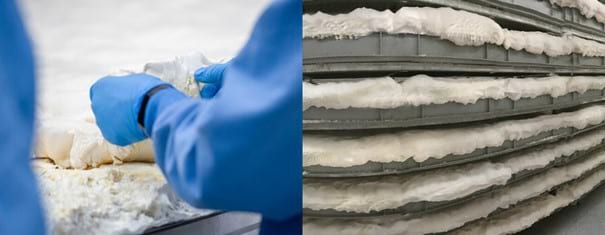
Image: Aerial hyphae production. Left: ecovative’s Air mycelium harvesting. Right: Bolt Thread’s vertical farms.
Once the mycelium foam is grown, it can be heat pressed to increase its density and heat-induce crosslinking of molecular bonds, thus generating a leather like material.
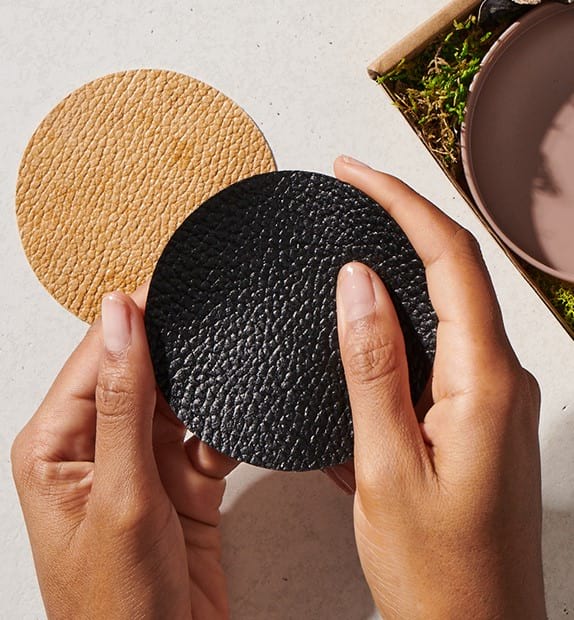
Image: BoltThread's Mylo leather, made from the compression of aerial mycelium.
Stella McCartney already used Mylo leather to make some garments that are not for sale... yet.
E- Design state of the art¶
Previous designers already tried to use biology for the upcycling of textile, or mycelium and textile together with the goal of creating a new material. Here is a short list of the already existing projects.
a- Ambercycle's polyester digester¶
Video: The Polyester Digester pitch for the 2016 H&M global change awards.
2016 H&M Global change award laureate Ambercycle is a project using synthetic biology to engineer microorganisms capable of digesting polyester (PET) into PTA. This organic processes with no carbon footprint would result in PTA that can afterwards be used to produce new polyester clothes, closing the loop of the polyester in our clothes. However, it seems like since 2016, the project has evolved and shifted towards a more chemical process. nevertheless, it has launched its goal of upcycling polyester.
Video: Ambercycle's current projects and axis of research.
b- Fungi for future, by Carole Collet¶
Carole Collet is a designer, a professor in Design for Sustainable Futures at the University of Arts of London and the Director of Maison/0. She explored a lot of aspects of the intersection of art, design and biology, especially with plants. In her project "Fungi for future", she explores the use of mycelium and fibers to form mycelium laces.

Image: Carole Collet's mycelium laces.
c- Emily Cai's work¶
Emily cai is an american textiles and material designer. In collaboration with Triin Talts and Mari Seger of Estonian Academy of Arts, Tallinn, she studied the process of cultivating mycelia and the opportunity for using mycelia-based materials as an alternative biomaterial for textile waste disposal. That way, she explored the use of mycelium as an accelerator of the biodegradation of natural textiles and came out with a proposal of industrial process for it called "The mycelium based textile factory.

Copiright © 2017 Emily Cai.